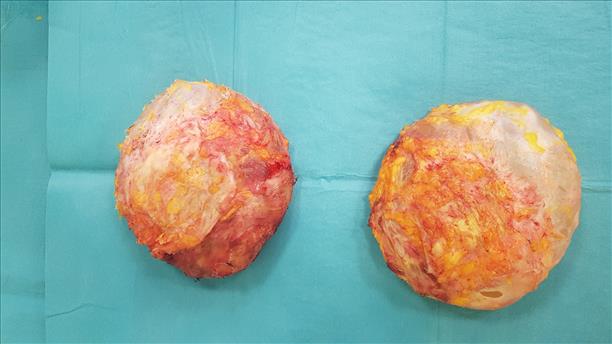
What is an en-bloc capsulectomy ?
An en-bloc capsulectomy is a surgical procedure which is carried out at the same time as a breast implant removal . It involves removing the membrane which develops around a breast implant together with the implant in order that the whole capsule is removed en-bloc.
When is a capsulectomy required ?
The membrane which develops around the breast implant may become hard and contracted over time resulting in firmness in the breast along with some change in shape. This is called a capsular contracture. In extreme cases and if left for a long time there may be some discomfort. A capsular contracture can occur in up to 10% of breast implant patients at which point a capsulectomy will be needed at the same time as breast implant removal or replacement.
If patients have suffered a breast implant rupture and develop a capsular contracture it is sometimes helpful at the time of surgery to remove the whole capsule en-bloc with the ruptured breast implant.
There are also situations when patients request a breast implant removal since they simply do not want implants any more. Under these circumstances if the capsule is very thin and soft a capsulectomy is not mandatory. However, a minority of patients may feel that their breast implants have been the cause of some vague symptoms of ill-health. Although there is no direct evidence in the scientific literature that breast implants cause any bodily symptoms of ill health some women in this situation decide to undergo breast implant removal. Some women are requesting the capsule to be removed at the same time using an en-bloc technique. However, it should be remembered that a capsulectomy is not always needed. Nevertheless, in view of reducing the anxieties around the issue an en-bloc capsulectomy can be offered but it is always important to discuss the options and take advice at the time of the consultation.
How is an en-bloc capsulectomy performed ?
The surgery for any procedure on a breast implant capsule will require a general anaesthetic. The capsulectomy or removal of the capsule can be performed piecemeal after removing the breast implant or it can be removed en-bloc together with the implant in one piece. The photo above shows both implants removed with the capsule removed entirely surrounding the implant. The implant on the left is a different shape since it has contracted and is distorting the shape of the implant within. The en-bloc technique is more difficult and does result in a longer scar. Any capsulectomy procedure will result in more tissue trauma and bleeding and therefore a drain is required for a variable period of time after surgery.
Is an en-bloc capsulectomy possible in every case ?
It may not be possible to perform an en-bloc technique if the capsule is very thin and translucent. However it is still possible to remove the whole capsule in separate pieces.
If breast implants are very large an en-bloc capsulectomy technique may not be possible since there will be insufficient space to reach the uppermost part of the capsule from around the curve of the implant since the incision is inferior. To attempt to do so would mean a very long scar indeed. In such situations it is better to remove the capsule in separate pieces.
Another situation is when patients have had a subpectoral ( under the muscle) breast implant the back layer of the capsule can be very adherent to the rib cage. If the capsule is very adherent to the rib cage there is a risk of making a small hole into the rib cage causing an air leak ( pneumothorax). In these situations it is better to leave a small area of capsule behind or to carefully remove it in separate pieces using a technique called hydrodissection
What is the recovery from an en-bloc capsulectomy ?
A one to two week period of rest before returning to work will be needed. It is recommended to refrain from exercise for a period of 6 weeks and during this time a sports bra should be worn
What are the risks of en-bloc capsulectomy ?
The main risks of an en-bloc capsulectomy technique are a longer scar and haematoma. The bleeding risks can be minimized with careful haemostasis at the time of surgery but a drain will be needed for a variable period of time after surgery but usually not longer than for 24 hours.
Since there is a cavity within the breast a clear fluid can accumulate in a small proportion of patients even two to three weeks later. This fluid is called a seroma. This can be drained with a needle aspiration or at the same time as an ultrasound scan.
Of course the breast will be smaller after implant removal but the capsulectomy may result in some further loss of breast tissue as well. Irregularities in the breast may also be a risk in patients with very thin breast tissue.
Any extensive surgery such as this can disturb the sensation and some degree of sensory loss is inevitable. It is quite common to develop permanent loss of sensation especially around the nipple and areola.
A caution about social media groups
It is important to remember that what you read from patient forums on line and social media may not represent accurate scientific and medical information . More importantly, each individual situation is different and therefore it is important to seek expert advice at consultation in order that you can make a fully informed choice about surgery.
Need more information ?
Mr Chana has been performing breast implant surgery for over 20 years with many of his own patients returning for replacement surgery. If you are interested in making an appointment for breast implant removal or replacement and need accurate advice about capsulectomy procedures use the contact form below or telephone his office for an appointment.
